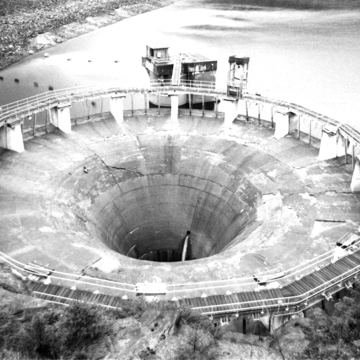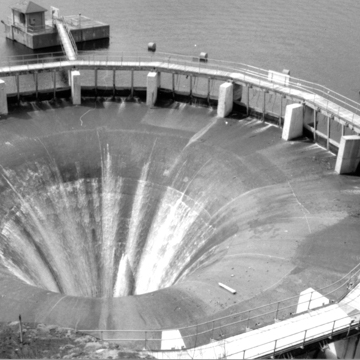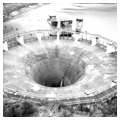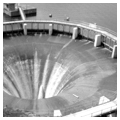You are here
Harriman Reservoir Flood “Morning Glory” Spillway
The first third of the twentieth century saw the completion of many great hydroelectric-power projects considered to be wonders of civil engineering. One of the largest in Vermont involved the construction of the 217-foot-tall Harriman dam. Extending 1,250 feet across the Deerfield River Valley, the earthen dam impounds 38 billion gallons of water to create the 2,184-acre Lake Whitingham, named for the town and settlements it inundated. The dam is protected from high water by this unusual spillway (one of the first of its kind), which functions like an escape drain in a bathtub that allows water to exit before it overflows. The Glory Hole—a term that may have come from the miners who excavated the rock for the downstream outlet—is a 180-foot-deep concrete funnel whose 160-foot-diameter rim is set at the desired level for the lake. In the event of a flood, the overflow drains into the spillway at a rate of 30 million gallons per second and is safely discharged below the dam rather than over it; this became known as a “morning glory” design because it resembles a blossom when water spills over its face. This is critical here because earthen dams quickly erode and crumble if crested. The New England Power Company built the Harriman Reservoir (named after one of its two original partners) and the dam as part of its Deerfield River hydroelectric system developed between 1909 and 1927. The engineering firms of Charles T. Main and S. G. White and Company, both from New York, were responsible for the design of the system and its structures, in association with H. K. Barrows of MIT and Frederick P. Stearns of Boston. In addition to the spillway and the dam, the powerhouse is equally notable. The three-story structure is steel framed and faced in brick, rising to form powerful arcades for the windows and entrances. The cornice and base are molded concrete, as are the gargoyles, crests, and horses in relief that accentuate the roofline and front entrance. The powerhouse generates 20,000 horsepower with its turbines on the river 2.5 miles below the dam.
Writing Credits
If SAH Archipedia has been useful to you, please consider supporting it.
SAH Archipedia tells the story of the United States through its buildings, landscapes, and cities. This freely available resource empowers the public with authoritative knowledge that deepens their understanding and appreciation of the built environment. But the Society of Architectural Historians, which created SAH Archipedia with University of Virginia Press, needs your support to maintain the high-caliber research, writing, photography, cartography, editing, design, and programming that make SAH Archipedia a trusted online resource available to all who value the history of place, heritage tourism, and learning.


















